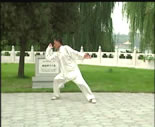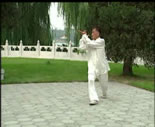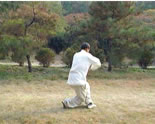Ba Gua Zhang is one of three sisters internal Kung Fu styles and the other two is Tai Ji Chuan and Xing Yi Chuan, As with Xing Yi and Tai Ji, the practice of Bagua generates vital energy for both health and combat purposes. Ba Gua Zhang uses palm techniques exclusively but outwardly is simpler in style, which makes it distinct from Xing Yi and Tai Ji styles.
Online Kungfu Video: Ba Gua Chang 3VCDs
Original price was: $65.00.$59.00Current price is: $59.00.
Description
Ba Gua Chang Introduction
Dong Hai Chuan of Wen’An County in Hebei Province came to Beijing in 1852 and began to teach his Ba Gua Zhang, which soon became very popular in Beijing, and the surrounding outskirts, and he was regarded as the respected founder of Ba Gua Zhang.
Ba Gua Zhang is one of three sisters internal Kung Fu styles and the other two is Tai Ji Chuan and Xing Yi Chuan, As with Xing Yi and Tai Ji, the practice of Bagua generates vital energy for both health and combat purposes. Ba Gua Zhang uses palm techniques exclusively but outwardly is simpler in style, which makes it distinct from Xing Yi and Tai Ji styles.
The basics of Ba Gua Chang are a series of movements done while walking in a circle, and quick footwork and turns are adopted as its self-defense strategy. The movements become faster and more intricate with turning and twisting once this practice is consistent, for practitioners can move the body in all possible angles and directions for fitness, centering and agility. Ba Gua Chang sets the emphasis on circularity; the movements of the Art include twisting, spiraling, turning and spiraling. Specifically, the Ba Gua Chang fighter is doing one of two things: either circling around a central point outside the body or rotating the body around its center. All styles of Ba Gua Zhang emphasize complete physical relaxation, correct skeletal alignment, natural movements which are in harmony with the body’s inborn reflexes and inherent design and that all movements are directed by the intent.
Utilizing ‘aggression’ through mobility of position and agility of body, Ba Gua Chang proves itself to be a formidable style for many practitioners. Instead of directly attacking an oncoming force, Ba Gua Chang ‘melts’ around the attack; either simultaneously redirecting the attack while closing the position, or by ‘ignoring’ it and repositioning one’s self to an advantageous ‘doorway’, for finishing the opponent instantly. This strategy allows the smaller and weaker fighter to apply maximum force from an angle at which the larger and stronger opponent cannot resist, effectively making the weaker fighter more powerful at that moment. Finally, the relaxed physical and mental state of the Ba Gua Chang fighter makes it possible for him to change and adapt as the situation demands. His movements are spontaneous and difficult to predict. Fighters of all disciplines agree that the unpredictable fighter is the hardest to beat.
The Chang (means Palm) is the usual terminology for a martial art. The open hand or palm is preferred by Ba Gua Chang because it creates a better energy flow within the body, an energy flow which can be directed for spiritual, martial, or healing purposes.
Ba Gua Chang practice is based on Walking the Circle and changing direction within the walk using twisting and spiraling movements called Changes. These exercises and techniques were developed from the Taoists’ Tao-Pursuing practices (Also called qigong or somewhat). They are all intended to increase the body’s vital energy. Depending upon the vital energy you make your own choices about the way you express that energy: martial, meditative, or therapeutic, etc.
The Single Palm Change is the most basic form and is the nucleus of the remaining palm changes found in the Ba Gua Chang practice. Besides the Single Palm Change, the other forms include the Double Palm Change and the Eight Palm Changes
Some of the major branches of Ba Gua Chang are
1. Cheng style (after Cheng Tinghua),
2. Yin style (after Yin Fu),
3. Jiang style (after Jiang Rong Qiao’s),
4. Liu style (after Liu Fengchun)
5. Ma style (after Ma Weiqi).
Liu Jing Ru is famous Chinese Ba Gua Chang inheritor and was born in Gao Yang County, Hebei Province. Now, serving as vice chairman and honored commissioner with Beijing Ba Gua Chang Research Association, he began his study of Cheng style Ba Gua Chang and Xingyi Chuan as early as the time when he was 10 years old and became an apprentice with Luo Xing Wu. Later he studied with He Zong Qi, the grandson of Mr. Yi Fu who created Yi Style Ba Gua Chang. During his long time Ba Gua Chang study, Liu Jing Ru also got hard-won directions from other Ba Gua Chang masters as Cheng You Xin, Liu Tang Feng, Wang wen Kui, etc.
Such 3 VCD are of English version and both the English subtitle and explanation can help practitioners well understand the essentials of such Kung Fu style.
It is the first among three VCDs and the contents covers:
1. Basics for walking in a circle
2. Basics for Ba Gua Chang
Such VCD is divided into many phases, in order to teach practitioners in a very quick way. Generally, the first is full demonstration of whole phase, then individual movements presentation, then movements application, then disciple gives a demonstration. It is English version.
Product Information
NAME: Ba Gua Zhang
Products No.:VCD0402
Price: U$59.00
Package: 3 VCDs, English Version
P.S. Please understand this is online videos. We will provide URLs for download once people place an order.













Reviews
There are no reviews yet.